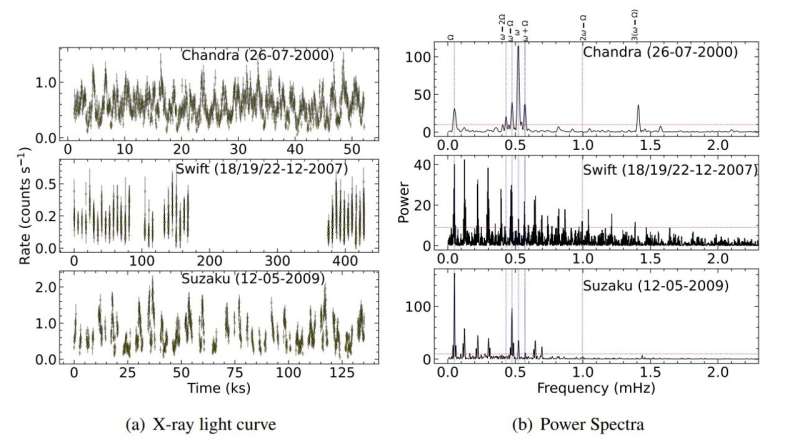September 14, 2023 report
This article has been reviewed according to Science X's editorial process and policies. Editors have highlighted the following attributes while ensuring the content's credibility:
fact-checked
preprint
trusted source
proofread
Astronomers investigate intermediate polar TX Columbae

Using various spacecraft, astronomers from India and Chile have performed X-ray observations of a peculiar intermediate polar known as TX Columbae. Results of the observational campaign, published September 7 on the pre-print server arXiv, shed more light on the properties and behavior of this polar.
Cataclysmic variables (CVs) are binary star systems consisting of a white dwarf accreting material from a normal star companion. They irregularly increase in brightness by a large factor, then drop back down to a quiescent state. Polars are a subclass of cataclysmic variables distinguished from other CVs by the presence of a very strong magnetic field in their white dwarfs.
In some CVs, accretion occurs through a truncated accretion disk when the white dwarf is moderately magnetic. These systems are known as intermediate polars (IPs).
Observations have shown that in IPs, the magnetic white dwarf spins asynchronously with the orbital period of the system and therefore produces a rapid oscillation with the spin period. Studying IPs could be crucial to better understand the complex physics of accretion and magnetic fields in compact binary systems.
TX Columbae (or TX Col for short) was initially identified as an X-ray source (1H0542-407) in the HEAO-1 all-sky survey. Based on the soft X-ray detection and optical pulsation, it was classified as an IP, about 3,000 light years away, with spin period of 1,911 seconds and orbital period of approximately 5.7 hours.
Some of the previous observations of TX Col have found that it is accreting predominantly via a disk, while some studies suggested that it is substantially accreting via stream, making it a disk overflow system. That is why a team of astronomers led by Jeewan Chandra Pandey of the Aryabhatta Research Institute of Observational Sciences (ARIES) in India, decided to take a closer look at the accretion process in this system. For this purpose, they analyzed observational data from Chandra, Swift and Suzaku satellites.
"We present the timing analysis of the intermediate polar TX Col in the X-ray band using the observations made by Chandra, Swift, and Suzaku during the years 2000, 2007, and 2009, respectively," the researchers wrote.
The study found that TX Col appears to accrete via disk as well as stream, being disk dominant accretor during the year 2000 and stream dominant accretor during the years 2007 and 2009. The properties of the system, including the spin and orbital periods, were found to be consistent with previous studies.
Furthermore, the research found that the power of dominant frequency changes from one observation to another. The astronomers noted that a similar result was obtained from the long-term high cadence data collected with NASA's TESS satellite.
Therefore, the authors of the paper concluded that TX Col is a variable disk-overflow system, changing its accretion mode from disk dominance to stream dominance and vice versa.
These changes, leading to variations in the X-ray emission from the system, can occur on timescales of hours to days and are thought to be due to instabilities in the disk and magnetic fields around the white dwarf. Similar behavior has been observed in few other IPs: FO Aqr, V2400 Oph, V902 Mon, Swift J0746.3-1608, and UU Col.
More information: Jeewan Chandra Pandey et al, X-ray observations of the Intermediate Polar TX Col, arXiv (2023). DOI: 10.48550/arxiv.2309.03674
Journal information: arXiv
© 2023 Science X Network




















